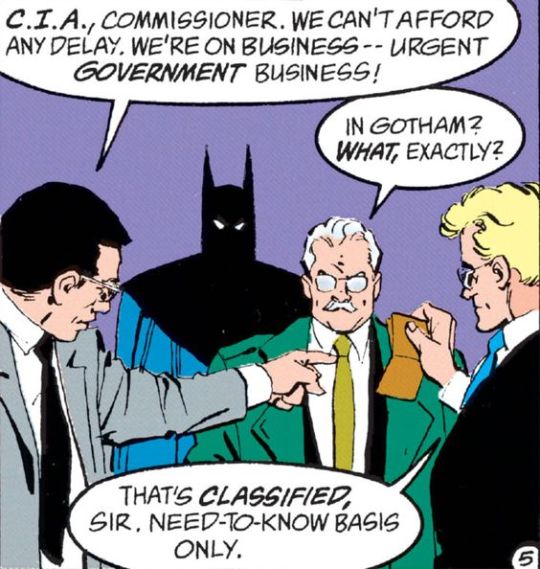#American C.I.A. agents
Explore tagged Tumblr posts
Text

#Seinen#anime and manga#black lagoon#Rei Hiroe#Manga#Revy “Two-hand” Lee#Rebecca “Revy” Lee#chinese american character#mentally unstable character#American C.I.A. agents
8 notes
·
View notes
Text



#Eda Blackwater#seinen#official art#official black lagoon spin off#Caucasian-American#C.I.A. Undercover agent#Glock 17L
7 notes
·
View notes
Text
It wasn’t so long ago that respectable psychologists didn’t really talk about “brainwashing.” The term had the slightly kitschy flavor of other Cold War embarrassments—C.I.A. spy cats and Reds-under-the-bed paranoia. But Google’s indispensable Ngram Viewer, which analyzes how frequently phrases appear in printed texts, confirms that the past two decades have seen an uptick in the word’s usage. What’s bringing brainwashing back?
One potential answer is the rise of technologies suspected of having mind-controlling powers, chief among them social media. Another is the entrenched political polarization of our time. When the cousin you kicked a soccer ball around with as a child starts spouting unhinged certainties about viruses, vaccines, and climate change—beliefs he treats as beyond debate—you might wonder: What happened to him? This isn’t just an ordinary disagreement. Could he have been . . . brainwashed?
Don’t get smug; he’s wondering the same thing about you. A few years ago, Psychology Today posted a checklist under the headline “Your Friend Might Be Politically Brainwashed If . . .” The last item on the list: “They assume that everyone who disagrees with them must be brainwashed.” So wait—does entertaining the possibility of having been brainwashed mean that you haven’t been? Or is that too easy?
Several recent books have taken up the subject of brainwashing—among them Daniel Pick’s “Brainwashed: A New History of Thought Control” (Profile), Joel E. Dimsdale’s “Dark Persuasion: A History of Brainwashing from Pavlov to Social Media” (Yale), and Andreas Killen’s “Nervous Systems: Brain Science in the Early Cold War” (HarperCollins). They share a scholarly squeamishness about the word they are forced to use for their subject matter. “Yes, the term brainwashing is silly and unscientific,” Dimsdale writes. “No one ever meant it literally, but the metaphor is a powerful one.”
In the new book “The Instability of Truth: Brainwashing, Mind Control, and Hyper-Persuasion” (Norton), Rebecca Lemov, a historian of science at Harvard, takes a different approach. She is often asked, she says, whether brainwashing really exists. “The answer is yes,” she writes, without any it-depends-what-you-mean-by hedging. In fact, she continues, “what we call brainwashing is not rare but common.”
Of course, words like “brainwashing” have no fixed meaning independent of their usage, which can be imprecise and expansive. When Frantz Fanon wrote of colonial efforts at lavage de cerveau in Algeria, or when a commentator in the seventies accused President Richard Nixon of having “brainwashed” white workers into fearing Communist infiltration, the word was gesturing at something, however loosely defined.
Yet the term’s recent resurgence raises suspicions. Accusations of brainwashing aren’t neutral claims; they offer a particular explanation for why someone holds beliefs we find preposterous. That explanation attributes those beliefs to deliberate manipulation instead of rational argument or personal conviction. In doing so, it may recast those with “deplorable” beliefs as victims rather than agents, deserving of not just condemnation but sympathy—and, perhaps, treatment. In the seventies heyday of the cults, that treatment was called “deprogramming.” Is this what our addled cousins need? A systematic re-indoctrination into conventionality?
The earliest appearances of the concept “brainwashing,” Lemov writes, occurred in the mid-twentieth century, in the files of the Office of Strategic Services, a precursor of the C.I.A. The term came to prominence owing in large part to the writings of an American journalist named Edward Hunter. He claimed that it was a rendering of a Chinese phrase, but it may have been, as he elsewhere claimed, a coinage of his own to describe Chinese persuasion techniques.
These techniques were most famously applied during the Korean War. As a prisoner of war, Morris R. Wills faced a gamut of privations—he was left malnourished and consigned to filthy conditions amid the ever-present threat of execution. Horror alternated with boredom. Conditions improved when Wills was transferred to what was called Camp One. The food got better, letters could be sent home, and there were even volleyball games.
That was, it seems, an early stage of a procedure known as reëducation. Wills was identified as a member of the exploited classes, a promising target for the method. Reflecting on his experiences many years later, he said, “Brainwashing is not done with electrodes stuck to your head.” It was, rather, “a long, horrible process by which a man slowly—step by step, idea by idea—becomes totally convinced, as I was, that the Chinese Communists have unlocked the secret to man’s happiness and that the United States is run by rich bankers, McCarthy types, and ‘imperialist aggressors.’ ”
The theory behind this method, as articulated by Chairman Mao, didn’t sound so bad. People could not be forced to become Marxists, Mao wrote. He recommended, instead, “democratic” methods of “discussion, criticism, persuasion, and education.” An important stage of the process was called “speaking bitterness.” American G.I.s, like the Chinese peasants on whom the method had first been tried, had a great deal of bitterness to speak: of racism and poverty back home, and of discrimination within the armed forces. Wills was made to introspect, to write an autobiography. He and other P.O.W.s were subjected to hours of lectures on Marxist theory.
Faced with the demand to justify “the American system,” Wills—unable to articulate what that even was—found himself moving in what his captors called a Progressive (as opposed to Reactionary) direction. American society was rotting, he came to believe; the Chinese way was the future. He chose not to be repatriated. But, where other prisoners who made the same decision were sent to work on farms and in paper mills, he was sent to the People’s University in Beijing.
The brainwashing process was never complete. Ostentatious acts of “repentance” were repeatedly demanded—Wills had already had to participate in “self-criticism” seminars. He was now taught more about Marxism and the history of China. He even witnessed a public execution. But he ended up staying in China for twelve years.
Wills’s retrospective accounts of his experience, once he was back in the United States and in a position to reflect on what had been done to him, are illuminating. It is plain that his Chinese captors had succeeded, at least for a time, in producing a genuine change of mind. He was, as he himself put it, “totally convinced.”
If we take Wills at his word, we might wonder about Mao’s claim that nobody can be coerced into sincere belief. In professing this, Mao echoes an old idea within modern European thought, one given its most influential expression in John Locke’s 1689 tract, “A Letter Concerning Toleration.” Locke condemned the use of coercion in matters of faith—the sort of thing we now associate with the Spanish Inquisitors—and among his arguments was that it simply couldn’t work. Real belief is a product of the “inward persuasion of the mind,” he wrote. An effective torturer can make his victims move their limbs as he tells them to, or even say the words—professions of faith, confessions of guilt—that he whispers into their ears. But “such is the nature of the understanding, that it cannot be compelled to the belief of anything by outward force.”
Locke’s point is connected to a more general philosophical claim about belief: that no one can just decide to believe something. Try believing, for instance, that the magazine (or computer or tablet or phone) in front of you is a venomous snake, or that your coffee mug is made of molten lava. You can cry out, if you like, but your steady heart rate will give you away.
For all that, you can surely be forced into situations where the desired conviction comes unbidden. Even in the seventeenth century, people saw the limitations of Locke’s view. An Oxford churchman named Jonas Proast agreed that belief could not be coerced directly, but, in his chilling words, the magistrate might lay “such Penalties upon those who refuse to embrace their Doctrine . . . as may make them bethink themselves.”
To force someone to believe something requires the concealment of the role that force has played in the process. The brainwashed can’t conceive of themselves as brainwashed; to do so would indicate that the brain remains unwashed. They can only coherently describe their experience as one of seeing the light, having their consciousness raised, being red-pilled. As Lemov quotes someone telling her about brainwashing: if the method works, it “erases itself.”
So, if your environment was tailored to exclude alternative views, should we say that you were being forced to believe something? Whether we call this coerced belief is a matter of terminological preference. Ways of making people believe things don’t divide neatly into the persuasive and the coercive—the brainwashing model gives the lie to that distinction. As Lemov writes, echoing the psychologist Edgar Schein, it is “neither pure persuasion nor sheer coercion but both: coercive persuasion.”
The phrase “coercive persuasion” effectively conveys the core objection to what it describes. It suppresses the fundamental exercise of human autonomy—it prevents you from making up your own mind. If that’s the case, would the criminal courts find you responsible for what you do when you’ve been brainwashed?
This question was decisively answered during the trial of Patricia (Patty) Hearst, in 1976. Two years earlier, Hearst, a granddaughter of the press magnate William Randolph Hearst, was an undergraduate at Berkeley. Her life changed forever when she caught the eyes of members of the Symbionese Liberation Army, an anti-capitalist guerrilla group. They abducted her and held her in a closet, blindfolded, for nearly two months. She was raped multiple times by the group’s leaders while in captivity, having been told that it would be “uncomradely” to refuse consent.
Shortly afterward, she was offered a nominal choice. Would she join them? Or did she wish to be freed? It was clear to her that the appearance of choice was illusory, that she was choosing between joining the group and being killed. She chose life. Or, as she later put it, “I accommodated my thoughts to coincide with theirs.” As with the Korean War P.O.W.s before her, mere pretense was not, under the circumstances, a real option. “By the time they had finished with me,” she later reflected, “I was, in fact, a soldier in the Symbionese Liberation Army.”
A little more than two months after her abduction, surveillance cameras captured Hearst robbing a bank in San Francisco, gun in hand. When she was eventually arrested, she weighed eighty-seven pounds and was—in the assessment of the psychologist Margaret Singer—“a low-I.Q., low-affect zombie.” The Yale psychiatrist Robert Jay Lifton interviewed Hearst for about fifteen hours and then declared her a “classic case” of brainwashing. During her time in custody, she repudiated her allegiance to the S.L.A. When she stood trial for her role in the bank robbery, her attorneys argued that she was a victim of coercion and duress.
It was a risky strategy. “I was brainwashed” was not a legally recognized defense. As Lemov, recounting the episode, points out, one of the psychiatrists who testified as an expert witness for the defense did Hearst no favors by admitting blithely that “brainwashing” was not a term of “any medical significance.” It had become, he said, “a sort of a grab bag to describe any kind of influence exerted by a captor over a captive, but that isn’t very accurate from the scientific or the medical point of view.”
The defense failed. Patty Hearst was convicted and sentenced to seven years in prison. After she had completed nearly two, President Jimmy Carter commuted the sentence to “time served.” It was only on Bill Clinton’s last day in office, in 2001, that she received a full pardon.
Why, Lemov asks, have lawyers found brainwashing “impossible to deploy as a legal exculpatory framework”? The concept evidently places defense lawyers in a double bind. If brainwashing doesn’t work, defendants can hardly claim it as a defense. But, if it does work, the defendants are acting on their own beliefs and no longer being coerced. An NPR interviewer forty years after the Hearst trial put the question in a revealing way: “Was she coerced, or did she become a believer?” Lemov rightly asks why it couldn’t be both. Why not say that “Hearst was coerced into becoming a true believer”?
The problem, as Lemov sees it, is that our intuitive model for thinking about brainwashing diagnoses it as a “rational, cognitive malfunction.” Hence the mockery to which the brainwashed are frequently subjected. The brainwashed soldiers of the Korean War were thought of as hapless dupes who “fell for” Communism, Lemov says. She invites us to consider a twenty-first-century parallel: the scorn directed at people who lose their savings to a cryptocurrency cult.
Lemov thinks that this perception shifts once we acknowledge the role of trauma in brainwashing. Maybe so. But how does this claim square with her broader hypothesis that “what we call brainwashing is not rare but common”? If trauma is a necessary condition for brainwashing, as she suggests, it follows that trauma is more widespread than we might assume. Yet she insists that she is not among the credulous sentimentalists who “see trauma everywhere.” How common, then, is brainwashing?
For recent historians of brainwashing, the issue carries high contemporary stakes. Joel Dimsdale, in “Dark Persuasion,” relates the disturbing case of Alexander Urtula, who took his life after receiving a staggering forty-seven thousand text messages from his girlfriend, who kept urging him to do so. Dimsdale asks, “If you can use social media to persuade an individual you know well to do something awful, can you persuade a wider circle of friends and acquaintances?” Given the resources—for instance, “troll farms” of the kind that state actors can muster—it appears that you sometimes can.
The power of such trolls lies in their ability to manipulate the epistemic environment. What was once a lone voice ranting at a street corner becomes a mutually reinforcing chorus. “When observers receive the same message from multiple sources,” Dimsdale writes, “they find the messages more believable, even if they are preposterous.” When President Trump tells us that “a lot of people are saying . . . ,” this claim, at least, is true.
There was outrage when it was revealed that Facebook researchers were tinkering with users’ emotions—making tiny tweaks to their feeds in what Lemov calls “massive-scale emotional engineering.” But she notes that the backlash didn’t stop the researchers from running these experiments; it just made them more reticent about their results. One researcher on the project said that the response amounted to people thinking, “You can’t mess with my emotions. It’s like messing with me. It’s mind control.”
And, in a sense, it is mind control. But that phrase, much like “brainwashing,” runs into a tricky question: Isn’t everything that shapes our thoughts, desires, or feelings a form of mind control? Lurking behind our unease is a fantasy of total, unshackled cognitive freedom. Any deviation from that ideal gets labelled as manipulation. If we cling to that standard, then, sure, we’re all brainwashed. But the standard is an absurdity. It’s obvious that our minds are shaped by the world we live in, including what others say. This isn’t what we have in mind when we talk about mind control.
Our idea, instead, is that to be free is not to be subject to the will of another. Lemov quotes an impassioned remark made by the Princeton sociologist Zeynep Tufekci about how online corporate power enlists “new tools and stealth methods to quietly model our personality, our vulnerabilities, identify our networks, and effectively nudge and shape our ideas, desires and dreams.” That’s the real worry these days—not just influence but control that’s hidden and personal.
Lemov’s emphasis on trauma suggests that the concept of brainwashing may not be all that helpful in understanding whatever it is that social media does to its users. Morris Wills was starved and terrified as a P.O.W. Patty Hearst was locked in a closet and sexually assaulted. Contemporary sociology invites us, perhaps rightly, to extend the traditional concept to include the working-class experience of deindustrialization and the precarity of the white-collar knowledge worker denied a secure job. The question still arises: What has your average TikTok user been subjected to that is remotely comparable to what Wills and Hearst endured?
There’s another irony here. Much of what Wills came to believe when he lived in China—that socialism is superior to capitalism, that the United States is an imperialist power run by a class of kleptocratic oligarchs—is shared by many young people today who were subjected to nothing more traumatic than a typical liberal-arts education. Their professors would, of course, balk at the implication that they’ve brainwashed their students, but that’s exactly what their critics in the conservative media have long been accusing them of.
It’s a familiar pattern in our polarized age. The right accuses the left of using the institutions it dominates—the federal bureaucracy, nonprofits, universities, Hollywood, and “legacy” media—to brainwash the public. The left, in turn, levels the same charge against the right, pointing to talk radio, partisan television networks, and manosphere podcasts. (Each side condemns the other’s social-media activity.) Naturally, no one admits to doing what they denounce in their opponents. But that’s to be expected: persuasion is what we do; brainwashing is what they do.
Does the case of the radical professor fit into this model of malign manipulation? Come to think of it, what exactly should we make of the Communists who brainwashed the American soldiers? Or the members of the Symbionese Liberation Army—mainly white, middle-class, and well educated—who appeared quite sincerely to believe their rhetoric calling for “death to the fascist insect that preys upon the life of the people”? Were they brainwashed into their beliefs, too? Or did they form them in the way that we all do—as the result of some half-conscious process only half mindful of evidence and truth?
We can grant that the term “brainwashing” has some utility as an explanation for what happened to certain individuals who were subjected to extraordinary stress and strenuous efforts at reëducation. But we needn’t reach for it when we seek to describe, and understand, the masses of people who fail to see what we find clear-cut. There are simply too many other ways of making sense of their beliefs.
Heterodox views—particularly antinomian ones—are attractive in part because they are at odds with the obvious. If our beliefs were obvious, how could we use them to distinguish our group from others? How could our beliefs be used to demarcate a social identity? Even in more mainstream precincts, plenty of our avowed beliefs—“our diversity is our strength”—may not be real beliefs at all, if belief is something that holds itself accountable to fact. In ways the philosopher Daniel Williams has explored, they are better understood as shibboleths, tribal anthems, expressions of commitment so deep that we cannot conceive of doubting them. Insofar as these clichés don’t express factual propositions, we shouldn’t apply to them the explanatory frameworks designed to tell us how people come to credit outlandish things.
We may be better served by looking to more conventional human motivations: our desire for approval from those around us, and the way social incentives can reward the outrageous and punish the reasonable. Social media strengthens these tendencies by indulging them and allowing them to operate on an unprecedented scope. Ordinary forces working on a vast scale often produce the effect of an extraordinary force.
Although beliefs can be badges—tribal markers chosen less for their empirical accuracy than for what they signal about us—plenty of people do buy into outlandish factual views. It’s not a cope, or a flex; it’s what they take to be reality. How about them?
There’s a well-meaning, if patronizing, ethical impulse behind our propensity to blame brainwashing for others’ convictions, whether they’re expressions of allegiance, hard factual commitments, or something in between. Labelling people as brainwashed casts them as one of the damned—lost souls whom we, as saviors, must redeem. Yet it might be our own savior complexes that we need to shed.
The philosopher Karl Popper, writing in 1960, suggested that the temptation to attribute misguided beliefs to sinister manipulation came from a mistaken assumption: that “truth is manifest.” If the truth were manifest, it would follow that the failure to grasp it must reflect “the work of powers conspiring to keep us in ignorance, to poison our minds by filling them with falsehood.”
But, even when confronted with a world of people holding views we find baffling, why assume that they’re victims of a grand conspiracy—or victims at all? Perhaps truth isn’t so obvious. Uncovering it demands effort and a bit of luck. Other people will take different things to be true because their paths—owing to differences in diligence or chance—diverged from ours. That conspiracy-minded cousin isn’t necessarily a casualty of mind control; he may simply have wandered down intellectual rabbit holes where evidence matters less than belonging. To depict him as a victim of manipulation grants him an unearned absolution. The most disturbing possibility isn’t that millions have been brainwashed. It’s that they haven’t.
16 notes
·
View notes
Text
When the final, declassified records from the John F. Kennedy assassination files were posted on the National Archives’ website last week, the first document researchers and reporters searched for was White House adviser Arthur Schlesinger Jr.’s June 1961 memorandum to the president titled “CIA Reorganization.”
ABC News led its initial coverage on the release of the JFK papers with that document, quoting Schlesinger’s now unredacted, dramatic, statistics that showed that the "CIA today has nearly as many people under official cover overseas as [the] State [Department].” The New York Times also featured that document with a headline “A Kennedy aide worried that the C.I.A. threatened the State Department’s power.”
Meanwhile, the National Security Archive (where I work) posted a fully blacked out page 8 from when the document was first declassified, juxtaposed with the now fully unredacted page revealing Schlesinger’s detailed report to the president that “47 percent of the political officers serving in United States embassies were CAS ” — agents working under diplomatic cover known as “Controlled American Sources.”
13 notes
·
View notes
Text
Batman: Shadow of the Bat #6: The Ugly American
Read Date: August 21, 2023 Cover Date: November 1992 ● Writer: Alan Grant ● Penciler: Dan Jurgens ● Inker: Dick Giordano ● Colorist: Adrienne Roy ● Letterer: Todd Klein ● Editor: Dick Giordano ●

**HERE BE SPOILERS: Skip ahead to the fan art/podcast to avoid spoilers (👏=didn't like it, 👏👏=it was ok, 👏👏👏=I liked it, 👏👏👏👏=I really liked it!, 👏👏👏👏👏=I loved it!)
Reactions As I Read: ● “Toyola” ^_^ I love the not-quite-name-brand names they come up with ● Batman just lurkin’

● 👏👏
Synopsis: Jon Kennedy Payne drives a car full of young kids off a bridge because they're driving a foreign-made vehicle. He goes to Sam's Place, a bar, looking for his daughter, Tina. He resorts to violence against the bartender to learn her whereabouts. Batman travels to the bridge where Commissioner Gordon listens to eyewitness testimony about the car crash. Three C.I.A. agents arrive trying to get through the police barricade. After threats don't work, Dr. Woolf pleads that their case is life or death and Gordon lets them pass. Batman follows in the Batmobile. Payne goes to Kim's Mini-Mart and finds his daughter there. When she introduces her husband, an oriental man, he gets violent accusing her of marrying the enemy. The C.I.A. agents go to Sam's Place where they learn that Payne had been there and find out where he's heading next. They leave and encounter Batman snooping around their car. They blow him off and head to Kim's Mini-Mart. Batman, however, has swiped Payne's file from the vehicle. From it, he learns that Payne's father died in the Korean War and, 20 years later during another war, Payne snaps at the sight of flag-burners. He was sent to prison for life leaving his wife and his 2-year old daughter behind. In prison, Payne underwent experimentation in exchange for a pardon. The experiments amplified his patriotism/prejudices as well as his fighting skills. When he went over the top, they resorted to keeping him in prison. He managed to escape.
Batman makes it to Kim's before the C.I.A. and manages to subdue Payne after a fight. When the C.I.A. arrive, they immediately kill Payne. Batman lashes out at the agents and threatens to take Payne's file to the press. Instead, he leaves the file with an anonymous note, with Payne's daughter. In the note he includes the name of a lawyer who specializes in anti-government lawsuits.
(https://dc.fandom.com/wiki/Batman:_Shadow_of_the_Bat_Vol_1_6)

Fan Art: DC Comics Batman watches over Gotham by Bruski12345
Accompanying Podcast: ● Quarter Bin Podcast - episode 32
2 notes
·
View notes
Text
American Dad!

Only 7 more months before American Dad! changes in late fall of 2024 as the is about to be rewritten on November 10th 2024, not a reboot but a continuation of the show. American Dad! seasons 1–19 and beyond will be focusing on friends and family.









11 main Characters of American Dad!
Stan Smith: He is the main protagonist of the show and works for the Central Intelligence Agency (CIA). Stan is a patriotic, conservative, and overly zealous American who often goes to extreme lengths to protect his country and family.
Francine Smith: Francine is Stan's wife and the mother of Steve and Hayley. She is a loving and caring wife and mother but often gets caught up in Stan's wild adventures. Francine is more laid-back and open-minded compared to Stan's strict ideology.
Steve Smith: Steve is the teenage son of Stan and Francine. He is an awkward and socially inept teenager who is often seen struggling with adolescence. Steve is obsessed with girls, pop culture, and his nerdy interests.
Hayley Smith: Hayley is the liberal and rebellious daughter of Stan and Francine. She is known for her strong political views and activism. Hayley often clashes with her father's conservative beliefs and frequently challenges his authority.
Klaus Heissler: Klaus is a goldfish who was once a human. Due to a CIA experiment gone wrong, his brain was transferred into the body of a fish. Klaus often longs to be human again and frequently engages in fish-related activities. He has an infatuation with Francine.
Roger Smith: Roger is a gray alien who lives with the Smith family. He crash-landed on Earth and has been hiding in the Smiths' attic ever since. Roger is a mischievous and unpredictable character who often disguises himself and takes on different personalities to interact with the outside world.
Jeff Fischer: Jeff is Hayley's on-again, off-again boyfriend. He is portrayed as a laid-back, stoner-type character who often finds himself in bizarre situations.
Debbie Hyman: Debbie is Steve's girlfriend, who is depicted as an overweight teenager. She is often portrayed as insecure due to her weight but is shown to be a caring and supportive partner to Steve.
Snot Lonstein: Snot is Steve's best friend. He is a socially awkward and nerdy teenager who is often seen by Steve's side. Snot and Steve share a close bond and often engage in various misadventures together.
Toshi Yoshida: Toshi is another one of Steve's friends. He is of Japanese descent and speaks mostly in Japanese, with his dialogue often being translated through subtitles. Toshi is known for his martial arts skills and his reserved and mysterious personality.
Barry Robinson: Barry is a classmate of Steve and a frequent target of bullying. He is depicted as overweight, socially awkward, and desperate for attention. Barry often provides comic relief with his eccentric behavior and attempts to fit in.




5 recurring characters include
Principal Lewis
Lisa Silver
Avery Bullock
Greg
Terry
The Main Plot is the escapades of Stan Smith, a conservative C.I.A. Agent dealing with family life, and keeping America safe.
Stan Smith - Stan works for the CIA, and is constantly on the look-out for terrorists. He loves his family and will do anything to protect them, and his country. Francine Smith - Stan's wife, she has had a past life of drugs, but she has carefully hidden her party-girl personality for the sake of the conservative man she loves. She met Stan after college. Hayley Smith - The teenage daughter of the family, currently attending community college. Despite her father's best efforts she has turned out to be a left-wing liberal. Stan loves his daughter, but that doesn't necessarily mean he trusts her. Steve Smith - The dorky son, he tries to act cool, but fails. Steve is on the verge of puberty - but he just can't quite make it. His low social status sometimes leads him to taking drastic action - but no matter what he does, he's just a dork. Steve is in love with Debbie vows to marry her. Roger - A sarcastic alien rescued by Stan from Area 51. He resents not being allowed to leave the house, so has resorted to drinking wine and smoking cigarettes. Klaus - A German-talking goldfish, he was a CIA experiment that went horribly wrong when they tried transplanting a German man's brain into a goldfish. Klaus lusts after Francine, and will take any opportunity that comes his way. Debbie Hyman - An overweight and often self-conscious teenager, she is portrayed as insecure and struggles with her body image but still maintains a close bond with Steve. She and Steve married later. Jeff Fischer - He’s Hayley's on-again, off-again boyfriend and eventual husband. He is portrayed as a laid-back, stoner-type character who often finds himself in bizarre situations.
Stan, Francine, Hayley, Steve, Roger, Klaus, Debbie, Jeff and Director Bullock are outcasts, family, hero and main characters of the show.
The 11 characters go on crazy adventures.
Debbie lives with her father Greg Corbin Hyman a news Anchor. Greg often rivals with Terry Bates Silver.
Steve and Debbie marries in season 6.
Hayley and Jeff marries in season 9.
Stan spends more time with his wife Francine, goes on missions and spends more time with his family.
Steve and Debbie keeps Snot, Toshi and Barry out trouble.
Stan, Debbie and Steve’s devoted efforts to keep Hayley and Roger out of trouble.
Stan Smith, Francine Smith, Hayley Smith, Steve Smith, Roger Smith, Klaus, Debbie Hyman and Jeff Fischer will enjoy family dinners at the smith house in 20 seasons.
American Dad is a feel good show.
The animated sitcom is about friends and family working together and never giving up.
#american dad#american dad fandom#stan smith#francine smith#hayley smith#steve smith#roger smith#klaus heissler#jeff fischer#debbie hyman#snot lonstein#toshi yoshida#barry robinson
5 notes
·
View notes
Text
The CIA’s Secret Quest For Mind Control: Torture, LSD And A ‘Poisoner In Chief’
CIA Papers Link Harvard To Mind-Control Project
80 Institutions Used In C.I.A Mind Studies
Cia Exploited Incarcerated Black Americans In Race For “Mind-Control” Agent
Memorandum For The Secretary Of Defense
Project Mkultra, The Cia’s Program Of Research In Behavioral Modification
The Secret Program Of Us. Mind Control Weapons: Isit Developing In Latin America?
Lengthy Mind-Control Research by CIA Is Detailed
Cia Artichoke Files

35K notes
·
View notes
Text
Nanotechnology Is Going To Be Way Hip Soon
In case you've missed the last few posts... Yes, I ordered, from my website at the time (livejournal.com/users/ohyourebel), the successful assassination of Osama Bin Laden before 9/11... The killers returned on August 4th, 2001 with the word that the job was done on the previous night... They chose that date because of the implications of marijuana use... Can you spot the 420 in that date? They were then murdered by government agents, unaware of what they and/or I had done, and so begins the cover-up of my involvement in the death of a most wanted terrorist... They told me as they were about to be shot to not tell anyone until I had the largest audience possible... I had told Swindler's List, which was the name they chose to be called for this operation, that I would provide them with $45,000 each upon a successful kill... They just showed up too early...

I also informed them that Bin Laden made statements that his involvement with the A.G. was authentic based on remorse over his marijuana use causing the bombing in '93... Osama said he hoped someday I would try that substance, that he might then know if I would start to think like he did... But that's how the rumor that Osama was C.I.A. began in earnest... For this alone, I believe I am owed the full amount of money offered by the United States for information regarding Bin Laden's whereabouts... Enough lies, okay? I know you're a frightened little child inside about this, America, but just let go... You're poisoning the minds of millions on Earth, every second, with your bullshit...
@nasa
In case you were wondering why they didn't show pictures of the corpse. He had my name written all over him.
Thanks to William T. Vollmann for reporting on Afghanistan prior to when their anti-American terrorism could be conducted. I couldn't have done any of this without reading The Royal Family and developing a sincere interest in his work.
Read.

"Never go against the family."
0 notes
Text

#seinen#anime and manga#black lagoon#revy lee#eda blackwater#Caucasian-American character#chinese american character#American characters#Gunslinger character#Lagoon company member#C.I.A. undercover agent#Nun Habit
13 notes
·
View notes
Text

#Official art#Glock 17L#black lagoon#seinen#rei hiroe#C.I.A. Agent#Cigarette#Eda Blackwater#Caucasian-American
9 notes
·
View notes
Text
Stan Smith’s Wild Family Adventures
A patriotic-C.I.A. agent, Stan Smith deftly attends to the affairs of his hectic job and a chaotic yet colourful family. This life involves alien roommates, political antics, and much more, creating a delightful combination of bedlam and high comedy, all while he walks down the National Security path. An animated series name American Dad where you can engage with a constellation of absurd humour, quirky characters, and unforeseen adventures.
0 notes
Text

Tulsi Gabbard’s remarks have made her a darling of the Kremlin’s vast state media apparatus — and, more recently, of President-elect Donald J. Trump.
By Steven Lee MyersJim Rutenberg and Julian E. Barnes
In 2017, when she was still a Democratic member of Congress, Tulsi Gabbard traveled to Syria and met the country’s authoritarian president, Bashar al-Assad. She also accused the United States of supporting terrorists there.
The day after Vladimir V. Putin began a full-scale invasion of Ukraine in 2022, Ms. Gabbard blamed the United States and NATO for provoking the war by ignoring Russia’s security concerns.
She has since suggested that the United States covertly worked with Ukraine on dangerous biological pathogens and was culpable for the bombing of the Nord Stream gas pipeline from Russia to Germany in September 2022. European prosecutors and U.S. officials say that sabotage was carried out by Ukrainian operatives.
Ms. Gabbard’s comments have earned her sharp rebukes from officials across the political spectrum in Washington, who have accused her of parroting the anti-American propaganda of the country’s adversaries. Her remarks have also made her a darling of the Kremlin’s vast state media apparatus — and, more recently, of President-elect Donald J. Trump, who this week picked her to oversee the nation’s 18 intelligence agencies and departments.
Her selection to be the director of national intelligence has raised alarms among national security officials, not only because of her lack of experience in intelligence but also because she has embraced a worldview that mirrors disinformation straight out of the Kremlin’s playbook.
No evidence has emerged that she has ever collaborated in any way with Russia’s intelligence agencies. Instead, according to analysts and former officials, Ms. Gabbard seems to simply share the Kremlin’s geopolitical views, especially when it comes to the exercise of American military power.
In Russia, the reaction to her potential appointment has been gleeful, even if Mr. Putin’s government remains wary of American policies, even under a second Trump administration.
“The C.I.A. and the F.B.I. are trembling,” Komsomolskaya Pravda, a Russian newspaper, wrote on Friday in a glowing profile of Ms. Gabbard, noting, positively, that Ukrainians consider her “an agent of the Russian state.” Rossiya-1, a state television channel, called her a Russian “comrade” in Mr. Trump’s emerging cabinet.
Russian media has emphasized Ms. Gabbard’s desire to improve relations with Moscow, according to FilterLabs, a firm that analyzes social media, state-run news organizations and other internet postings to track public sentiment in Russia.

“Gabbard fits an overall pattern of Trump breaking with much of the post-Cold War consensus,” said Jonathan Teubner, the chief executive of FilterLabs. “She is, for Russia, the one that perhaps most perfectly embodies the changes they were hoping for from the U.S.”
Mr. Trump’s critics called the choice a dangerous one that would undermine national security and that signaled a deference to Mr. Putin’s worldview.
“Nominating Gabbard for director of national intelligence is the way to Putin’s heart, and it tells the world that America under Trump will be the Kremlin’s ally rather than an adversary,” Ruth Ben-Ghiat, a professor of history at New York University and the author of “Strongmen,” a 2020 book about authoritarian leaders, wrote on Friday. “And so we would have a national security official who would potentially compromise our national security.”
Asked for comment on Ms. Gabbard’s pro-Russia stances and her amplification of Moscow’s messaging, Trump transition officials sent a copy of the president-elect’s comments when he announced his pick: “I know Tulsi will bring the fearless spirit that has defined her illustrious career to our intelligence community.”
If confirmed, she would have responsibility to oversee the very agency that monitored and called out Russian disinformation and influence efforts throughout the 2024 campaign.
She faces an uphill battle for confirmation in the Senate.
Among members from both parties, her tacit support of Russia’s war aims in Ukraine and her repetition of Kremlin disinformation have raised doubts about whether she should be given oversight of the intelligence agencies, including the responsibility of preparing the highly classified daily intelligence briefings for the returning president.
In choosing her, Mr. Trump signaled his deep distrust of those agencies. During his first administration, he publicly rebuked senior intelligence officers when their assessments differed from his own. Ms. Gabbard’s iconoclastic views over the years suggest that she shares that distrust, especially when it comes to Russia and the war in Ukraine.
In several public appearances and in social media posts, she has outlined a policy not different from the views of Vice President-elect JD Vance, who has also emerged as a critic of American support for Ukraine.
If confirmed, Ms. Gabbard would not be the only voice on intelligence matters. John Ratcliffe, Mr. Trump’s final director of national intelligence in his first administration, has been chosen to be C.I.A. director. Ms. Gabbard would, however, still be influential in determining what intelligence Mr. Trump and other top officials see in the daily intelligence briefing, and would be in a position to highlight intelligence that reinforces Mr. Trump’s views.
For Ms. Gabbard, the invitation to join Mr. Trump’s administration represents a stunning political evolution. Only four years ago, she sought the Democratic presidential nomination, albeit as an anti-establishment candidate, and endorsed President Biden when he won the nod.
Since then, however, she has broken with the Democratic Party and drifted toward a conspiratorial view of the world and American power in it.
“This war and suffering could have easily been avoided if Biden Admin/NATO had simply acknowledged Russia’s legitimate security concerns regarding Ukraine’s becoming a member of NATO, which would mean US/NATO forces right on Russia’s border,” she wrote on Twitter, now known as X, when the war began in February 2022.
A month later, she posted a video on the platform saying the United States was operating 25 to 30 biological research labs in Ukraine. She accused the Biden administration of covering them up and said they could release dangerous pathogens, though she stopped short of claiming the labs were making biological weapons, as Russia has falsely claimed.
Ms. Gabbard’s remarks were quickly called out by Republican members of Congress, including Representative Adam Kinzinger of Illinois and Senator Mitt Romney of Utah.
Her willingness to criticize the Biden administration has made her, like other prominent critics of the government, a favorite source of anti-American content on Russia’s state television networks.
Vladimir Solovyov, a popular talk show host, called her “our girlfriend” in a segment in 2022. The program included an interview Ms. Gabbard did with Tucker Carlson in which she claimed that Mr. Biden’s goal was to end Mr. Putin’s control of the Russian government, according to Julia Davis, the creator of the Russian Media Monitor, which tracks Kremlin propaganda.
In fact, Ms. Gabbard honed her pro-Russia views on Mr. Carlson’s show on Fox News before his program was canceled. She became a regular guest and occasionally filled in as host when Mr. Carlson was away.
Clips from her appearances on Mr. Carlson’s show that repeated Kremlin talking points were quickly picked up by Russian state media.
In some cases, she echoed story lines that Russia’s propagandists created, which the Russians then recycled on their own media as evidence that the conspiracy theories they had manufactured were true. For the Kremlin, it was a virtuous cycle.

The frequency of her citations on Russian state television prompted sharp criticism and attention inside the U.S. government. Hillary Clinton, the former first lady, secretary of state and Democratic presidential nominee in 2016, once called her a “Russian asset.”
Ms. Gabbard, 43, has an eclectic political background, often occupying a space where the left and right overlap — such as in their opposition to foreign military intervention and a more sympathetic view of Russia.
She began in state politics in Hawaii at 21 and emerged as a talented, charismatic young Democrat, though one who often espoused the culture-war views of today’s right, taking early positions against abortion and same-sex marriage, for instance.
At the time, she was closely aligned with her father, Mike Gabbard, a leader of Hawaii’s movement against same-sex marriage. At one point, she inveighed against “homosexual activists” who were, she said, forcing “their values down the throats of the children in our schools.” (The statement came during her mother’s run for the state school board in 2000.) By the time she ran for Congress in 2012, she had expressed support for abortion rights and for same-sex marriage, later stating in a video apology that her earlier views on gay issues had been shaped by her father.
In 2003, she joined the Hawaii Army National Guard and served in Iraq in 2004 and 2005 as a specialist with a medical unit of the 29th Infantry Brigade Combat Team. After attending officer training in Alabama, she served a second tour in the region as a military police officer in Kuwait. She left the guard in 2020 to join the Army Reserve, where she continues to serve with the rank of lieutenant colonel.
In interviews, she has cited her military service as a factor in her political views about the exercise of American military might.
In 2013, she opposed President Barack Obama’s ultimately aborted plans for airstrikes against Syria. She later criticized the administration for failing to properly call out “Islamist extremists.” She also questioned evidence showing that Syrian forces used chemical weapons in an attack that killed dozens.
In 2016 she opposed the favorite for the Democrats’ presidential nomination, Mrs. Clinton, becoming an ardent supporter of her chief Democratic rival that year, Senator Bernie Sanders of Vermont.
Her willingness to challenge the Democratic establishment earned her an invitation to visit Mr. Trump at Trump Tower during the 2016 presidential transition period.
It also made her an appealing figure for conservative news bookers, particularly those for Mr. Carlson’s Fox News show. On one show, the two agreed that U.S. support for Syrian rebels seeking to topple Mr. Assad was aiding terrorists — an interview that came as Russia bombed U.S.-backed rebels in the name of combating terrorism.
Ms. Gabbard ultimately became a paid Fox News contributor, as Mr. Carlson was emerging as an ardently anti-interventionist, and increasingly pro-Putin, figure in the MAGA movement.
As Russian forces gathered before their invasion of Ukraine in February 2022, Ms. Gabbard joined Mr. Carlson to speak out against Mr. Biden’s move to impose new sanctions against Russia, even as she said she opposed Russia’s military operation. “The reality is that these sanctions don’t work whether they were put in before or now or later,” she said. “What we do know is that they will increase suffering and hardship for the American people, and this is the whole problem with the Biden administration.”
Her appearances were regularly picked up by Russia’s state media, including the international network RT, which promoted her critiques and lauded her with headlines such as “Tulsi Gabbard dares to challenge Washington’s war machine” and “Biden wants regime change in Russia — ex-congresswoman.”
By this year, Ms. Gabbard’s politics converged with Mr. Trump’s. In October, she joined the Republican Party and hit the campaign trail on his behalf, extolling him as a peacemaker.
“A vote for Donald Trump is a vote for a man who wants to end wars, not start them,” she said at Mr. Trump’s rally at Madison Square Garden shortly before Election Day, “and who has demonstrated already that he has the courage and strength to stand up and fight for peace.”
https://www.nytimes.com/2024/11/18/us/politics/tulsi-gabbard-trump-russia.html
0 notes
Text
Christopher Nolan
The famous British director Christopher Nolan was born in London, England, on July 30, 1970. He is well known for his unusual narrative methods and unusual visual style, which is defined by a gloomy and enigmatic mood. Among his most renowned productions are the surreal thriller "Inception" (2010), the space opera "Interstellar" (2014), the riveting war drama "Dunkirk" (2017), and several Batman films. Oscar Award for Best Director (2024) for Nolan's masterwork "Oppenheimer" (2023), which also won the esteemed Best Picture award, recognised his extraordinary brilliance.

His early life
Nolan was raised in Chicago and London, with an American mother and a British father. He attended the boarding school Haileybury, which is close to London, as a young boy. From an early age, Nolan would use his father's Super-8 camera to make short films, which sparked his enthusiasm for filmmaking. The immersive dystopian films of Ridley Scott and George Lucas's Star Wars trilogy served as sources of inspiration for him.
After completing his English literature studies at University College London, Nolan went on to work as a corporate and industrial training video director. Simultaneously, he devoted himself to his first feature film, Following (1998), about a writer's dangerous search for inspiration. It took Nolan fourteen months of unyielding dedication to get this project through to completion. After the movie's success at festivals, Nolan moved to Hollywood with his producer wife, Emma Thomas.
His work
The film Inception (2010), directed by Christopher Nolan, was the finished product of a project he began eleven years earlier. The movie, which stars Leonardo DiCaprio as a corporate spy with the capacity to enter dreams, centres on his character's attempt to transcend technological constraints and implant a concept in a person's head. With the critical and commercial success of Inception, Christopher Nolan was nominated for a second Academy Award for best original screenplay. Furthermore, Nolan contributed to the development of the narrative for the 2013 Man of Steel, a Superman reboot.
After that, Nolan directed the science fiction drama Interstellar (2014), which he co-wrote with his brother. The movie follows a group of scientists who want to use wormhole technology to transport humans from a war-torn and starving Earth to another planet. Subsequently, he wrote and directed the 2017 war picture Dunkirk, which is about the evacuation of Allied forces from France in World War II. Widespread praise and several Academy Award nominations, including one for Best Picture, were bestowed upon this compelling drama. Furthermore, Nolan was nominated for an Oscar for his outstanding directing. He developed and directed the action-packed thriller Tenet in 2020, which centres on a C.I.A. agent's quest to avert a world war and features time travel.
The 2023 film Oppenheimer, directed by Christopher Nolan, depicts the role played by American theoretical scientist J. Robert Oppenheimer in the development of the atomic bomb as well as the security hearing that followed because of his alleged ties to communism. The filmmaker decided to cast Cillian Murphy, who had worked with Nolan on other movies, as the main role. The movie won a lot of awards, including best picture and best director for Christopher Nolan. Oppenheimer won the best film drama award, while director Christopher Nolan received a Golden Globe for his work.
His cinematography
Famous for his distinctive filmmaking techniques and cinematography, Christopher Nolan's artistic approach has come to embody these attributes. The following are some essential elements that define his methodology:
Non-Linear Storytelling: To get the viewer to participate in piecing together the plot, Nolan frequently uses non-linear narratives, delivering stories out of chronological order.
Practical Effects: He feels that actual, on-set effects add to the realism of the cinematic experience, hence he favours them over computer-generated imagery.
In-Camera Techniques: Nolan's films are more realistic since he is renowned for creating visual effects in-camera rather than through post-production.
IMAX and Film: Because of IMAX's better resolution and texture, he strongly supports the use of premium, larger-format film stock.
Style of Documentary Lighting & Hand-Held Camera Work: Nolan frequently uses hand-held camera work and natural lighting to give his films a grounded, realistic vibe. Sound & Music: Working with composers such as Hans Zimmer, Christopher Nolan's films are renowned for their potent soundtracks that complement the visual story telling.
0 notes
Note
May I recommend Sleeping Beauties by Suzanne O’Sullivan:
“In O’Sullivan’s view, this explains the lack of progress on Havana syndrome, the mystery disorder that, like a plot twist in a Jason Bourne movie, has struck scores of American diplomats and spies, beginning in Cuba in 2016.Victims complained of hearing a strange noise before the onset of debilitating symptoms — headaches, nausea, dizziness, visual disturbances and memory loss — prompting American officials to speculate about enemy attacks via “sonic weapon.” And though dozens of prominent specialists have argued that the syndrome bears the hallmarks of mass psychogenic illness, doctors working for the government have dismissed the idea as tantamount to calling victims malingerers or fakes. In August, The New York Times reported that the C.I.A.’s leading theory involves microwave energy beams and Russian agents. O’Sullivan isn’t buying it. She devotes a chapter to the syndrome, methodically demolishing the sonic weapon theory as well as clinical papers that purport to document victims’ brain injuries. At the same time, she chronicles the fraught history of recent U.S.-Cuban relations, and the furor of hyperbolic statements about the disorder given by doctors and amplified by politicians. Hers is a risky move, an armchair analysis made, as she admits, without access to actual patients or classified intelligence. But here, as elsewhere in her book, O’Sullivan’s logic is, well, infectious.“Havana syndrome was a powerful sociopolitical wave,” she points out. “Many people were caught up in it, including U.S. Embassy staff, politicians and doctors.” She goes on: “I cannot imagine how hard it would have been to resist developing symptoms in that setting, and how difficult it would have been to accept a mass psychogenic explanation with all the ‘experts’ disparaging it so.” Who’s to say Havana syndrome won’t yet turn out to be another striking instance of science “making up people”?“
Source: https://www.nytimes.com/2021/09/23/books/review/the-sleeping-beauties-suzanne-osullivan.html
What's your take on Havana syndrome?
I can't tell you what's been making some US diplomats feel sick while abroad (or even if there is one underlying cause for the clusters of illnesses, as opposed to unrelated outbreaks and incidents). What I can tell you is that the narrative that the US government is trying to push in the media about it is batshit insane.
Their argument is: the Cuban government has secretly developed highly-advanced sonic weaponry, and also successfully managed to use them on US diplomats in the middle of a thaw in which they were trying to improve relations. For this to be true:
Cuba would have to have one of the most advanced militaries in the world (they do not)
The Cuban military would have to be experienced in utilizing hypersonic weapons without detection (zero evidence of them doing anything even kinda like this before)
The Cuban government would have to be objectively stupid: immediately after successfully opening negotiations with the US after decades of trying, their plan is to secretly attack the US with some James Bond bullshit (no living creature is this stupid)
There is not one single part of this narrative that makes the least amount of sense. The alternative hypothesis I've seen them shopping to some media outlets is that it was actually Russian diplomats in Cuba secretly doing the attacks on US diplomats in order to disrupt US-Cuban negotiations, but that would be a historically risky move to accomplish what is at most a minor geopolitical balancing priority of the Russian government. It's one thing to poison a dissident, it's another thing entirely to set up military infrastructure in a foreign country and secretly fire noise weapons at US government officials.
I don't know what the truth is, but I'm fully confident that it isn't the story they're giving us
11K notes
·
View notes
Text
Hello there.
This is the main blog of the Committee for Identification of Anomalies
We encourage readers of the blog to send inquiries and reblog with text
Expand post for additional information
Clarification. (AkA: hi, its me, the owner of the blog. Allow me to explain "in charachter" what are you looking at)
this is an arg-like blog that doesnt use unreality tags
All image credit (whenever the image isnt made by the blog creator) is in the first comment or at the top of the post
Object PO-80X is the ask tag.
@preservationofnormalcy is one of the many other blogs that take care of things. They are very good at their job.
The SCP Foundation (and any other funny groups from the wikidot site) dont exist. The actual foundation does appear sometimes thru multidimensional travel but uuuuh they dont do much actually
These are the following types of entity (who have the appropiate tag)
Anomaly: generic term
Object: usually a physical "something" that sometimes is useful for C.I.A. operatives. Sometimes its just a "cursed something"
Phenomenon: unexplained phenomenons who have happened only once.
Entity: usually they are unidentified creatures that display some degree of sentience or "life"
There is a Management.
There are 13 Ranks
List of roles (will update every once in a while)
Agent: standard member, Jack of all trades, maybe you get a customizable gun, it can be any pistol and it can also be either concealed or in a holster.
Researcher: most of the time people dont want to shoot at either the anomalies or the people that want them. Sometimes people just want to study what the anomalies *ARE* rather than Glorified Target Practice
Representatives: rare and difficult job to get, but thats because they're the face of C.A.I. across the globe (even though 90% of operations are in american soil), and are effectively the only way the general public can interact with us.
Coverts: sometimes we gotta do psyops or something "hush-hush" and... well... lets just say training is extremely hard for a reason.
We dont interact much with other groups. Whatever.
1 note
·
View note
Text

20th Anniversary of Black Lagoon.
#Two-hands#Revy#Balalaika#Roberta#Eda#Black Lagoon#Rebecca Lee#Sofiya#Rosarita Cisneros#Edith Blackwater#American#Russian#Colombian#Shenhua#Taiwanese/Chinese#Chinese-American#Household head Maid#F.A.R.C. Mercenary soldier#Gunslinger#C.I.A. Agent#Mafia boss#Assassin#Black Lagoon 20th anniversary#Rei Hiroe
76 notes
·
View notes